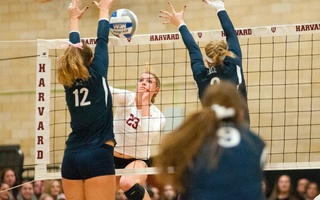When junior Alister Bent and classmate Sindhu Vegesena step onto the volleyball court, there are two obvious characteristics that set them apart from their fellow teammates.
For one, both are clad in a different color jersey than the rest of their teammates. More significantly, both players are among the shortest on their teams.
The different color and smaller size have the same explanation: Bent and Vegesena are liberos—a special defensive position in indoor volleyball that is responsible for controlling serve receives and converting them into solid passes. The libero remains in the game at all times and is the only player who isn’t limited by the rules of rotation.
“They’re not allowed to hit over the net at all,” Bent said. “Basically their role is to be the primary serve receiver, so they should be the best passer and the best defensive players as well.”
In a game where height is traditionally an advantage, the fact that the shorter liberos stay in the game at all times may seem like an inconvenience. However, their lack of height is far from detrimental.
“Defense is actually easier when you’re shorter,” sophomore setter Corinne Bain said. “You can dive easier and be closer to the ground. It gives you more time to dig the ball.”
Dressed in a different color jersey so officials can easily track their movements, liberos emerged internationally in the late 1990s. While the direct aim of introducing such a position was to improve defense and ball movement, it also indirectly gave shorter players a chance to continue their volleyball careers.
At 5’7", Bent jumped at the chance to swap from his high school position of outside hitter to libero, as it meant being able to play college volleyball.
“I definitely wouldn’t have had an opportunity [to play college volleyball] coming out of high school being 5’7”," Bent said. “Having the libero position was definitely a chance for me to come into the program. It’s been huge in that respect."
However, other liberos such as Vegesena took a different path and developed at that position from an early age. Chosen for her high energy and desire to control the ball, Vegesena was taught how to channel these aspects of her athleticism into becoming a libero.
“I started playing club volleyball as a nine-year-old on a 12’s team, so I was shorter…than all my teammates,” Vegesena said. “I was also hyper and the worst kind of ball hog, so having that [libero] jersey gave me an excuse to behave the way I did.”
Now standing 5’8", Vegesena has come a long way from her childhood volleyball days. As libero, Vegesena is responsible for a much larger part of the court than her teammates.
The libero has been compared to the goalkeeper in the sense that it’s the job of the libero to prevent any balls from hitting the ground. On the other hand, the position also bears similarities to football quarterbacks because liberos are the first to touch the ball off the serve and therefore control the trajectory of the pass to the setter.
“When the ball’s coming to you, there’s no hiding,” Bent said. “Any ball that’s going and it’s not clear who’s ball it is, it’s the liberos. It’s their job to hustle and make sure nothings hits the ground…. Communication is key.”
Although the height requirements to play a libero are a prerequisite, the mentality required to hit the ground again and again in each game without having the satisfaction of scoring is something that needs to be cultivated. Vegesena’s discipline to play such a position came from her coaches as she got older.
Read more in Sports
Women's Golf Finishes 10th at NCAA RegionalsRecommended Articles
-
Car Strikes StudentJohn C. Beck '60 is "progressing satisfactorily" at Peter Bent Brigham Hospital, after being struck by an automobile while he
-
Medical School Reveals Library PlanUniversity has revealed long ed plans for the new Francis A. way Library of Medicine, the larg niversity-centered medical library
-
Over the WireWASHINGTON--House Republicans; bent on unwavering support of the Ruml "skip-a-year" tax plan, today put off until Thursday a conference on
-
 Women's Volleyball Opens Season With Pair of Wins
Women's Volleyball Opens Season With Pair of Wins -
 Women's Volleyball Brings Home Ivy Title for First Time Since 2004
Women's Volleyball Brings Home Ivy Title for First Time Since 2004













